
Cooking Temperatures

On the kitchen oven is a really cool dial. I turn it to 350 and trust that the oven will heat up to and remain at 350 degrees. I put in the food, set the timer, and go do something productive. When camp cooking in the outdoors, there's a bit more hit-or-miss.
On my dutch oven, there's no dial, nothing to tell me how hot the oven is. Since cooking food at a fairly consistent and known temperature is important for success, there are 3 ways I know of for estimating temperature. Depending on your skill level and how you'll be cooking, one of them should work for you.
Also keep in mind that there are many environmental factors that will influence your oven temperature. Wind might blow heat away; colder air temperature, higher humidity and higher elevation reduce heat generated by coals; direct sunlight makes a black oven a bit hotter. You might consider making an aluminum foil wind shield to place around your oven, but if it is that windy, I would recommend you not have an open fire.
Nearly all dutch oven cooking will come out ok if your dutch oven is about 350 degrees. Some things should be cooked hotter and some cooler, but that's the temperature for all recipes that fail to include a temperature suggestion.
Hand Test
Use your hand to feel the heat. Of course, every person has a different sensitivity to heat but this works well for me. Just remove the lid from the dutch oven and place your hand just above or just inside the oven. Count how many seconds you can keep your hand there before it gets too hot. It is about 50 degrees per second counting down from 550, so I just count - "550, and 500, and 450, and 400, and 350, and 300, ...".
| Seconds | Temperature |
| 1 | 500+ |
| 2 | 500 |
| 3 | 450 |
| 4 | 400 |
| 5 | 350 |
| 6 | 300 |
| 7 | 250 |
| 8 | 200 |
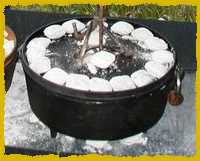
Counting Charcoal
Lots of dutch oven cookbooks tell you how many charcoal briquettes to put under and on top of the oven. This is the easiest way to cook since every coal is similar and consistent.
If you are like me and use real wood for your outdoor camp cooking coals, it doesn't help much. Also, different brands of charcoal give off different amounts of heat.
But, let's say you are going to use charcoal...
The normal formula for Baking is to use twice the number of briquettes as the diameter of the oven with 3/4 of them on the lid. For a 12 inch oven, you would use 24 briquettes with 18 on top and 6 underneath.
For Frying, use the same number of coals as the diameter of the oven with all of them underneath. For a 12 inch oven, you would use 12 briquettes under it.
Here is a simple chart:
| Baking, Roasting | More heat from top so bottom does not burn. Place 3/4 coals on top and 1/4 underneath. This provides a uniform heat to the contents. |
| Frying, Simmering, Boiling | All heat from bottom. Place all coals underneath. The lid may be on or off. |
Here's a little tool to figure out your briquette placement for your outdoor cooking.
I'd love to hear from you if it was helpful.
Rule of 3
This is a real simple estimate of briquettes. Take the dutch oven diameter and add 3 briquettes on top. Subtract 3 briquettes underneath. So, a 12 inch oven would have 12+3=15 on top and 12-3=9 underneath. This works for any size dutch oven. Then you need to adjust briquette placement depending on the type of cooking.
I feel this method puts too much heat under the dutch oven. Maybe a "Rule of 4" or "Rule of 5" would be closer to what I use. Fortunately, you can always move coals around as needed depending on what you like.
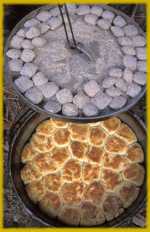
Rings of Coals
As it turns out, the sizes of briquettes work out so that the recommended briquettes count above can be estimated easily. As an experiment, you can take a 12 inch dutch oven and 24 briquettes. On the lid, make a ring of briquettes all the way around the outer edge. How many did you use? I bet it was 16 or 17.
Now, see how many it takes to make a ring just under the oven. There should be 2 or 3 briquettes between each leg for a total of 6 to 9.
That is pretty close to the recommendation for a 350 degree baking set up, isn't it? It works pretty well for any size dutch oven and any size briquettes - smaller briquettes means you need more of them, but its about the same amount of burning mass to make a ring!
A ring around the top and the bottom is about 350 degrees.
Remove every other briquette underneath to make about 300 degrees.
Add a second ring to the top to make about 400 degrees.
If your camp cooking calls for stewing or frying, you'll want to drop those top coals down and shove them under the oven. If you're baking breads, then maybe move a couple from underneath up to the top.
Just remember that a ring around the top and a ring around the bottom is your base starting point and tweak it from there.
Oh, I forgot to mention that this is exactly how I do it with real wood coals. Since coals are irregular and you can't count them, I put a ring of coals around the top and bottom and it works out practically perfect. I'm lazy and like the simplest way to do something. :-)
Maintaining Even Heat
No matter how evenly you distribute your coals above and below your dutch oven, there will be some spots that get hotter than others due to wind, quality of fuel, and phase of the moon. To prevent burned and raw portions of your meal, you should just rotate your oven occasionally, maybe every 10 minutes. You can do it however you like, but I've got an easy way - remember, I'm lazy.
- Lift the whole oven off the campfire cookin coals by the wire bail.
- Turn the oven clockwise 1/3 of a revolution.
- Set the oven back down on the coals - with three legs on your oven, it should sit in the exact same spot it started in with coals between the legs.
- With a lid lifter or pliers, grasp the lid handle.
- Twist the lid counter-clockwise 1/3 turn - the logo on the lid should be in the same position it started at.
Taking a quick look inside at this time will give you an idea if the coals are cooking too fast or slow. Just be careful to not drop ash in or let heat out.
Maintaining Long Heat
Your first batch of coals will probably keep the oven hot for 30 to 45 minutes. That's long enough to cook most things, but you sure don't want to let the oven go out for those 1 hour or longer meals.
Just make sure you check your oven every 20 or 30 minutes to see that the coals are ok. Where you see spaces with just white ash, fill in with a few more coals. Or, you can just brush all the ash and coals away and put on a new batch all at once. If we're just sitting around the campfire cooking s'mores, talking, or playing cribbage, I tend to do the former but if the fish are biting I do the latter so I don't need to keep checking on it.
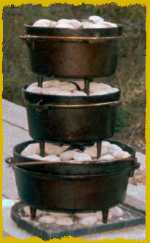
Stacking Heat
When you really get going and have 3 or 4 dutch ovens outdoors cooking, there is a lot of ground space chewed up and a large part of the heat from the coals is heating the surrounding countryside instead of the ovens. I recommend that the first dutch oven you buy is a 12 inch model and then your second purchase is a 10 inch model. This allows you to stack the ovens.
Stacking your dutch ovens is a great way to save ground space, fuel, and time - besides, it looks really cool to have 3 ovens making a tower.
The coals on the lid of one oven serve as the 'underneath' coals for the oven stacked on top. And, the oven on top helps trap heat for the oven underneath. All this makes heat estimating more difficult so you should only tackle this after you've got some experience and are willing to practice on a few meals.
The most important thing to remember is that items needing more heat should be on top. Your bread or dessert should be the bottom-most oven since it wants very little heat underneath. Then, your meat to roast in the middle and a stew on the top. It takes some planning, but an entire meal can be fixed this way so it all gets done at the same time.
Rotating stacked dutch ovens takes a bit more work. Take off the top ones, rotate the bottom one, and then work your way back up the stack. Move as fast as you can without spilling so you keep the ovens hot.
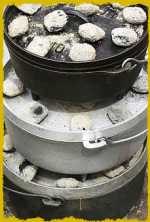
Temperature Tips
Finally, just a few tips to tuck away for later:
- You can cook food, but you can't unburn food. Use less heat and cook longer rather than overheating.
- Preheat your dutch oven for frying or searing meat. Otherwise, put the food in cold and let it all heat up together.
- Keep adding wood to your campfire to ensure you have a supply of camp cooking coals available. If your fire burns too low, it may take extra time to finish your cooking while you make coals.
- Some briquette users just set new briquettes next to burning ones around the dutch oven so they light and continue providing heat as the first batch burns out.
Comments:
It requires us to bring to a boil and then simmer 3-4 hours. We do not have a stock pot, so we thought we would use our dutch oven outside instead.
Any advise.
Thank you,
Terry Ann Whitby
Thanks!
RE: Stewing at 350
Stewing is a multi-part process. Simmering on the stove top is the latter part. The initial step for stewing is a low and slow baking in a humid environment. Thus to stew meat you use a dutch oven to maintain a humid place inside your larger oven. Set the dial, place the meat in the DO and the DO inside the oven. The meat really should cool completely before adding the liquid ingredients, but there isn't always enough time for that. Stew meat should always be very well marbled/
Thank you
Love this site, it's the best I found yet!
Just bought a DO. made amazing chicken on my first outing using charcoal bricks. I would like to learn to use only wood as you do so, I am not reliant on carrying around or finding bricked test. do you have any tips, other than wood types, on using wood?
thanks,T
Using pieces of wood that are 1 to 2 inches in diameter creates good sized coals that break apart - too big and it's just a burning log, too small and the coals don't last.
Keep the fire burning in an appropriate spot (like a fire pit) and scoop coals out to a cooking spot as needed.
Make sure the wood is not rotting or insect infested.
Really, I can't think of anything that makes using wood more challenging than briquettes.
Thank you for the information.
I need to make cobbler for 18 people in a deep dish 12in DO and wonder what the difference in Cooking time will be. I am doubling the recipe and originally it says 20mins.
Heating a DO really only takes a couple minutes. As long as you are right there with it, it's fine to heat it first. Most cooking does not really need it, though. Some things, like cookies and breads turn out better when the DO is already warmed up.
When you use on the fire do you add coals to the lid as described for charcoal?
Does stove top cooking work?
Does doubling recipes work? (Thinking of desert for a large group)
Thank you for all your great information!
And, like I said, I'm lazy and look for the easiest way to do things - setting legs in the same spots means I don't have to think so hard. Some people place the feet on small, flat bricks and you kind of have to rotate in thirds if you do that. (It does help the coals get air and not smother)
For a 14-inch DO, use about 1/3 more ingredients than called for using a 12-inch DO.
Use a grill surface instead of plate, to segregate the ashes from the combustion area and keeps the briquettes alone.
In the lids brush away the ashes before open it, every 45 minutes and replaced with new briquettes.
I have been D O cooking about 15 years but forget tips and methods since I don't cook outside every month. More often in the summer and fall.I forget tips and other info over the winter and spring.
Thank you.
We love outdoor dutch oven cooking, but I've always felt that I was using too many charcoal bricks.
This article was exactly what I needed to refine my cooking process - Thank you very much,
cb
Much thanks in advance.
Barbara
2 - Pie pans
1 - Smaller Cake pan
4 - Metal nuts
3 - Alligator clips
Place nuts in bottom of pie pan
Place cake pan on nuts
Place food in cake pan
Place second pie pan on top
Seal with Alligator clips
Works well for individual meals. Each scout carried one.
Next question is the lid handle. A solid plate of iron. Any tool or suggestion for getting the lid off with briquettes and hot. Seen suggestion of drilling a hole and vice grips.
Thanks
Yes, 3 underneath and 6 on top should give a pretty good heat on a 6-inch diameter dutch oven.
Vice grips sound like the best option for lifting the lid. Or, heat-resistant gloves to just pick it up by the edges.
Thanks from central Indiana,
Max
Cook On!
Peter
Thanks
Find more Dutch Oven Resources at DutchOvenDude.com
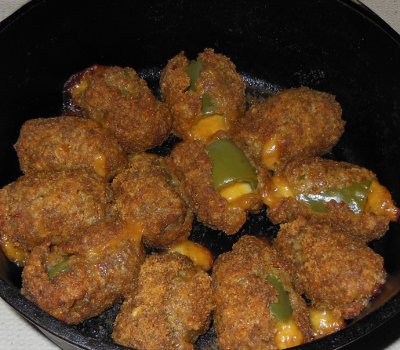


Recent Comments